各国民族服装英文介绍备课讲稿
- 格式:ppt
- 大小:7.80 MB
- 文档页数:34
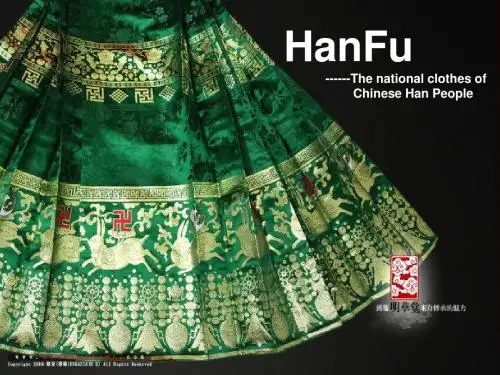
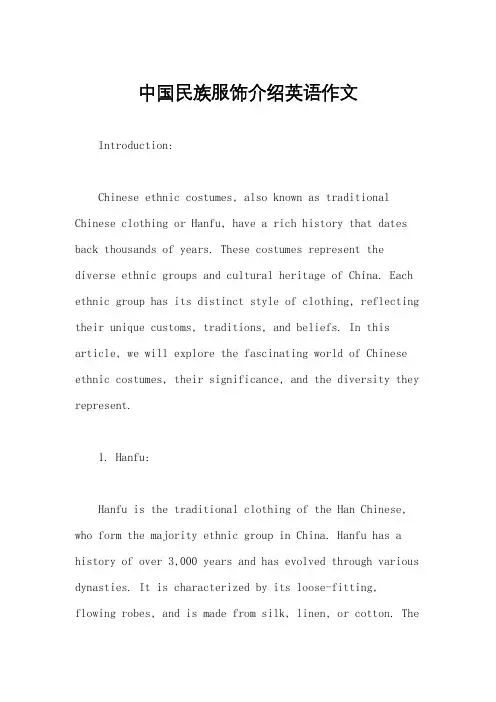
中国民族服饰介绍英语作文Introduction:Chinese ethnic costumes, also known as traditional Chinese clothing or Hanfu, have a rich history that dates back thousands of years. These costumes represent the diverse ethnic groups and cultural heritage of China. Each ethnic group has its distinct style of clothing, reflecting their unique customs, traditions, and beliefs. In this article, we will explore the fascinating world of Chinese ethnic costumes, their significance, and the diversity they represent.1. Hanfu:Hanfu is the traditional clothing of the Han Chinese, who form the majority ethnic group in China. Hanfu has a history of over 3,000 years and has evolved through various dynasties. It is characterized by its loose-fitting, flowing robes, and is made from silk, linen, or cotton. Thestyle and design of Hanfu vary depending on the gender, social status, and occasion.For men, Hanfu typically consists of a robe, a long skirt, and a sash. The robe is often adorned with intricate embroidery and exquisite patterns. Women's Hanfu, on the other hand, includes a long, flowing dress called a Ruqun, which consists of an upper garment and a skirt. The Ruqun can be further embellished with accessories such as a waistband, a shawl, and a headdress.Hanfu represents the elegance, grace, and modesty of ancient Chinese culture. It is often worn duringtraditional festivals, weddings, and other formal occasions to showcase the wearer's respect for tradition and their cultural identity.2. Tibetan Costume:Tibetan costumes are unique and distinct, reflecting the rich cultural heritage of the Tibetan people. The traditional Tibetan costume for men is called a "Chuba." Itis a loose, long-sleeved robe made of wool or silk. The Chuba is often adorned with colorful patterns and intricate designs. Men also wear a waistband and a hat called a "Tsepa" to complete their traditional attire.Women's traditional Tibetan costume is called a "Chuba" as well, but it is more elaborate and vibrant compared to men's. It consists of a long, flowing dress with a widebelt around the waist. The dress is often made of silk and is adorned with intricate embroidery, vibrant colors, and traditional Tibetan motifs. Women also wear various accessories like jewelry, headdresses, and aprons to enhance their traditional look.Tibetan costumes are not only worn on special occasions but are also a part of daily life. They represent the Tibetan people's strong connection to their culture, religion, and natural surroundings.3. Uygur Costume:Uygur costumes are an integral part of the Uygur ethnicgroup's cultural identity in China. The Uygur people, who primarily reside in the Xinjiang Uygur Autonomous Region, have a unique and diverse clothing style influenced bytheir nomadic heritage and Islamic traditions.Uygur men traditionally wear long, loose-fitting robes made of silk or cotton. The robe is often paired with loose trousers and a hat. The colors and patterns of their clothing represent their cultural and religious beliefs. Uygur women wear vibrant, long-sleeved dresses called "Atlas" or "Kemis." These dresses are made of silk and are adorned with intricate embroidery and vibrant patterns. Women also wear a headdress, usually made of silk, which is decorated with beads, feathers, and other ornaments.Uygur costumes are not only visually appealing but also reflect the Uygur people's history, lifestyle, andreligious practices. They are often worn during festivals, weddings, and other celebrations to showcase their cultural pride and identity.4. Zhuang Costume:The Zhuang ethnic group, one of the largest minority groups in China, has its unique traditional costumes that reflect their rich cultural heritage. Zhuang costumes are known for their vibrant colors, intricate embroidery, and exquisite craftsmanship.Zhuang men traditionally wear a collarless jacket, loose trousers, and a headscarf. The jacket is often made of silk or cotton and is adorned with colorful embroidery. Women's traditional Zhuang costume, known as "Luozhuang," is even more elaborate. It consists of a jacket, a long skirt, and an apron. The jacket and skirt are often made of silk and are embellished with intricate embroidery, silver ornaments, and colorful ribbons.Zhuang costumes are not only worn on special occasions but are also a part of the Zhuang people's daily life. They represent their cultural pride, social status, and their connection to their ancestors and nature.Conclusion:Chinese ethnic costumes, with their diverse styles, designs, and cultural significance, are a testament to the rich heritage and diversity of China's ethnic groups. Each costume represents a unique blend of history, tradition, and cultural identity. Whether it's the elegant Hanfu, the vibrant Tibetan costume, the Islamic-influenced Uygur costume, or the intricate Zhuang costume, these traditional attires showcase the beauty and cultural pride of the Chinese people. Preserving and promoting these costumes is crucial in maintaining the cultural diversity and heritage of China.。
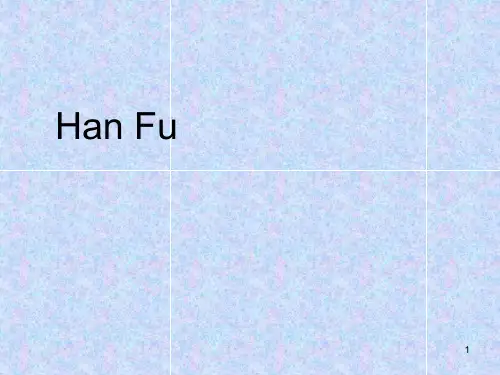
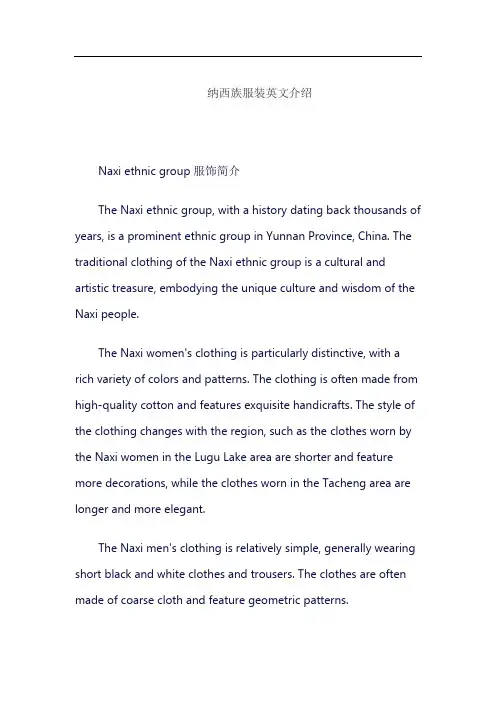
纳西族服装英文介绍Naxi ethnic group服饰简介The Naxi ethnic group, with a history dating back thousands of years, is a prominent ethnic group in Yunnan Province, China. The traditional clothing of the Naxi ethnic group is a cultural and artistic treasure, embodying the unique culture and wisdom of the Naxi people.The Naxi women's clothing is particularly distinctive, with a rich variety of colors and patterns. The clothing is often made from high-quality cotton and features exquisite handicrafts. The style of the clothing changes with the region, such as the clothes worn by the Naxi women in the Lugu Lake area are shorter and feature more decorations, while the clothes worn in the Tacheng area are longer and more elegant.The Naxi men's clothing is relatively simple, generally wearing short black and white clothes and trousers. The clothes are often made of coarse cloth and feature geometric patterns.In recent years, with the development of tourism in China, more and more people have been to Yunnan Province, and many scenic spots in Yunnan have become popular tourist destinations. One such place is Lugu Lake, which is known as "the cradle of the Naxi people" because it is the birthplace of the Naxi people. In this area, many Naxi people still wear their traditional clothing every day, making their unique culture more visible to outsiders.The traditional clothing of the Naxi ethnic group not only represents the culture and history of the Naxi people but also embodies their attachment to their land and their way of life. It is a cultural heritage that should be protected and inherited.以下是该文本的翻译:纳西族服饰文化介绍纳西族是中国云南省一个有着悠久历史的著名民族。
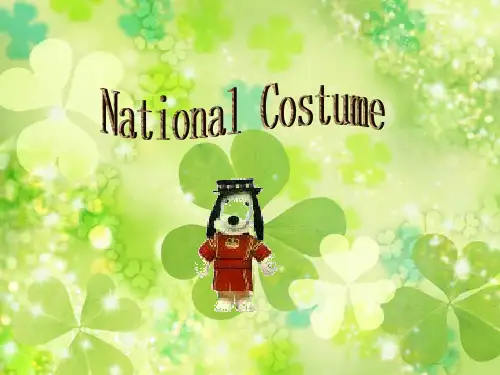



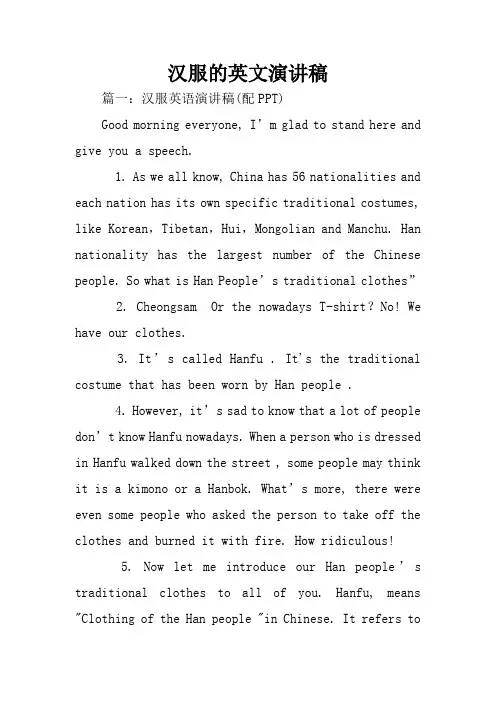
汉服的英文演讲稿篇一:汉服英语演讲稿(配PPT)Good morning everyone, I’m glad to stand here and give you a speech.1. As we all know, China has 56 nationalities and each nation has its own specific traditional costumes, like Korean,Tibetan,Hui,Mongolian and Manchu. Han nationality has the largest number of the Chinese people. So what is Han People’s traditional clothes”2. Cheongsam Or the nowadays T-shirt?No! We have our clothes.3. It’s called Hanfu . It's the traditional costume that has been worn by Han people .4. However, it’s sad to know that a lot of people don’t know Hanfu nowadays. When a person who is dressed in Hanfu walked down the street , some people may think it is a kimono or a Hanbok. What’s more, there were even some people who asked the person to take off the clothes and burned it with fire. How ridiculous!5. Now let me introduce our Han people’s traditional clothes to all of you. Hanfu, means "Clothing of the Han people "in Chinese. It refers tothe pre-17th century traditional clothing of the Han Chinese .It has the history of more than 3000 years. And it influenced Japanese kimono and Kroean hanbok.6. Hanfu is wrapped around the body with the left side over the right, which just looks like the letter ‘y’ when seen from the front. But there are also other kinds of collars.Hanfu(汉服)has many patterns. Ruqun(襦裙)is worn by women.7. When its collar likes the letter “y”,we can called it Jiaolingruqun(交领襦裙).8. If its collar likes the number“11”,we can called it duijiuqun(对襟襦裙).9. When it is classified by its height of the skirt,we can called it qiyaoruqun(齐腰襦裙)——Which waistband is on the waist.10. Or qixiongruqun(齐胸襦裙)——Which waistband is above the chest .11. There is another kind of Hannfu. When its edge is bent ,we can call it Quju(曲裾)12. As we can see, Hanfu has many features , like curve, graceful ,elegant, generous and unfettered.13. According to the Han people’s tradition,there are many important days. One the day you are 15(for girls) or 20(for boys).We will hold a ceremony to celebrate to be an adult. And remember the responsibility.14. Nowadays, many people love our traditional culture , so they wear Hafu, found clubs, hold activities and so on. This summer, Chengdu’s Cherry Blossom Festival, a little girl who dressed in Hanfu left a deep impression on visitors . Here are some pictures of her. She is really cute, isn’t she15. Chinese civilization, also called "Hua-Xia" . "Hua" means the beauty of the dress anddecoration which is Hanfu clothing; "Xia"("Shia") is the grandeur of rites and social conduct. And Hanfu reflects the philosophy of Chinese people: Living elegantly and poetically.I like Hanfu, so today I’m not just telling youa type of clothing called Hanfu. I hope more and more people focus on our traditional culture and don’t let such precious and beautiful things disappeared. OK , that’s all what I want to say, thank you.篇二:英语演讲-汉服-演讲稿1、History(历史)A:Hanfu(汉服) is the traditional costume that has been worn by Han Chinese people for approximately 5000 years. It is believed to have been worn by the early leader of China, Huangdi. It's the significant cultural symbol of Chinese civilization2、Han Dynasty(汉代)A:The Han dynasty praised highly of zhou li zhi(周礼制),so Han Closes was spread in the whole country.B:Han dynasty was a dynasty whose conception of centralization was the most early, most complete, most advancing, most powerful. (汉朝的中央集权的国家概念最早,最完备,最先进,最强大。
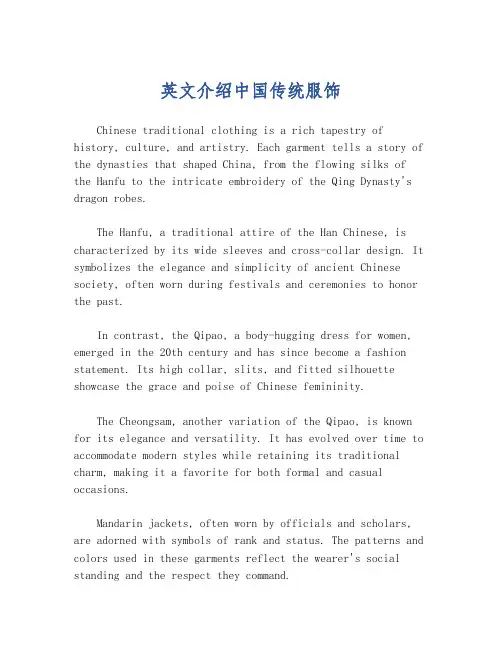
英文介绍中国传统服饰Chinese traditional clothing is a rich tapestry of history, culture, and artistry. Each garment tells a story of the dynasties that shaped China, from the flowing silks of the Hanfu to the intricate embroidery of the Qing Dynasty's dragon robes.The Hanfu, a traditional attire of the Han Chinese, is characterized by its wide sleeves and cross-collar design. It symbolizes the elegance and simplicity of ancient Chinese society, often worn during festivals and ceremonies to honor the past.In contrast, the Qipao, a body-hugging dress for women, emerged in the 20th century and has since become a fashion statement. Its high collar, slits, and fitted silhouette showcase the grace and poise of Chinese femininity.The Cheongsam, another variation of the Qipao, is known for its elegance and versatility. It has evolved over time to accommodate modern styles while retaining its traditional charm, making it a favorite for both formal and casual occasions.Mandarin jackets, often worn by officials and scholars, are adorned with symbols of rank and status. The patterns and colors used in these garments reflect the wearer's social standing and the respect they command.The Zhongshan suit, a modern adaptation of traditional attire, is named after Sun Yat-sen, the founding father of modern China. It combines elements of Western and Chinese fashion, symbolizing unity and progress.Accessories such as the Ruyi, a jade scepter, and the fan, a symbol of refinement, were integral to traditional Chinese attire. They not only served practical purposes but also conveyed social messages.In conclusion, Chinese traditional clothing is more than just garments; it's a reflection of the nation's soul, aliving testament to the rich heritage that continues toinspire and influence fashion today.。
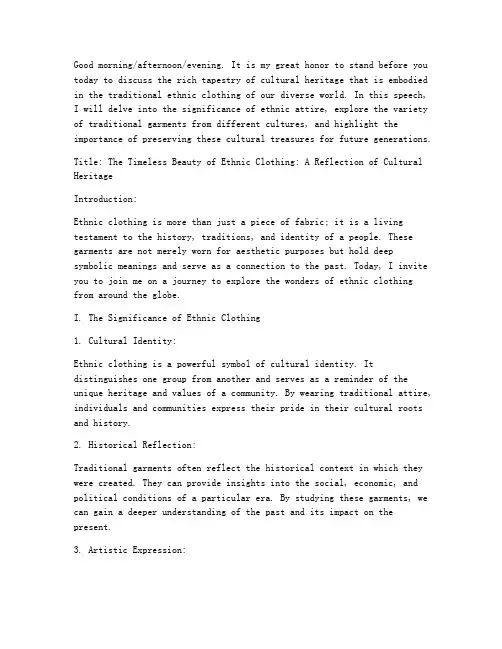
Good morning/afternoon/evening. It is my great honor to stand before you today to discuss the rich tapestry of cultural heritage that is embodied in the traditional ethnic clothing of our diverse world. In this speech, I will delve into the significance of ethnic attire, explore the variety of traditional garments from different cultures, and highlight the importance of preserving these cultural treasures for future generations.Title: The Timeless Beauty of Ethnic Clothing: A Reflection of Cultural HeritageIntroduction:Ethnic clothing is more than just a piece of fabric; it is a living testament to the history, traditions, and identity of a people. These garments are not merely worn for aesthetic purposes but hold deep symbolic meanings and serve as a connection to the past. Today, I invite you to join me on a journey to explore the wonders of ethnic clothing from around the globe.I. The Significance of Ethnic Clothing1. Cultural Identity:Ethnic clothing is a powerful symbol of cultural identity. It distinguishes one group from another and serves as a reminder of the unique heritage and values of a community. By wearing traditional attire, individuals and communities express their pride in their cultural roots and history.2. Historical Reflection:Traditional garments often reflect the historical context in which they were created. They can provide insights into the social, economic, and political conditions of a particular era. By studying these garments, we can gain a deeper understanding of the past and its impact on the present.3. Artistic Expression:Ethnic clothing is a form of artistic expression that showcases the creativity and skill of a culture. The intricate designs, patterns, and embroidery techniques employed in these garments demonstrate the high level of craftsmanship and artistic prowess of the people who created them.II. Variety of Traditional Garments1. Asia:In Asia, traditional clothing varies greatly from one country to another. For example, in China, the Tang Suit and the Hanfu are popular garments, while in Japan, the Kimono and Yukata are iconic. In India, the Sari and the Dhoti are worn by both men and women, and in Pakistan, the Shalwar Kameez is a common attire.2. Africa:African ethnic clothing is renowned for its vibrant colors and intricate designs. The Maasai shuka, the Kente cloth of the Ashanti people in Ghana, and the Adire cloth of the Yoruba people in Nigeria are just afew examples of the rich tapestry of African attire.3. Europe:European traditional clothing varies from the ornate corsets and lace of the Victorian era to the rugged woolen garments worn by the Norsemen. The Dirndl dress of Austria and the Smock of the Netherlands are other notable examples of European ethnic attire.4. North America:Native American tribes have their own unique traditional garments, such as the Apache blanket, the Navajo saddle blanket, and the Iroquois moccasins. These garments often feature symbolic designs and patternsthat represent the spiritual beliefs and cultural identity of the tribes.5. South America:In South America, the Guatemalan huipil and the Peruvian poncho are popular traditional garments. The intricate embroidery and vibrant colors of these pieces reflect the rich cultural heritage of the region.III. The Importance of Preserving Ethnic Clothing1. Cultural Preservation:As globalization continues to erode cultural boundaries, it is crucial to preserve the traditional ethnic clothing of various cultures. These garments serve as a tangible link to the past and can help future generations understand and appreciate their cultural roots.2. Economic Benefits:The traditional ethnic clothing industry can provide economic opportunities for artisans and communities. By promoting and selling these garments, cultural heritage can be sustained and contribute to the economic development of a region.3. Educational Value:Studying ethnic clothing can provide valuable insights into the history, art, and social customs of different cultures. It can foster cultural exchange and promote mutual understanding among people from diverse backgrounds.Conclusion:In conclusion, ethnic clothing is a vital part of our global cultural heritage. These garments serve as a bridge between the past and the present, connecting us to our ancestors and reminding us of the rich diversity of human cultures. As we move forward, it is essential to cherish and preserve these cultural treasures for future generations. Let us celebrate the beauty and significance of ethnic attire and continue to honor the traditions and identities they represent.Thank you for your attention, and I hope that this speech has inspired you to appreciate and support the preservation of ethnic clothing around the world.。